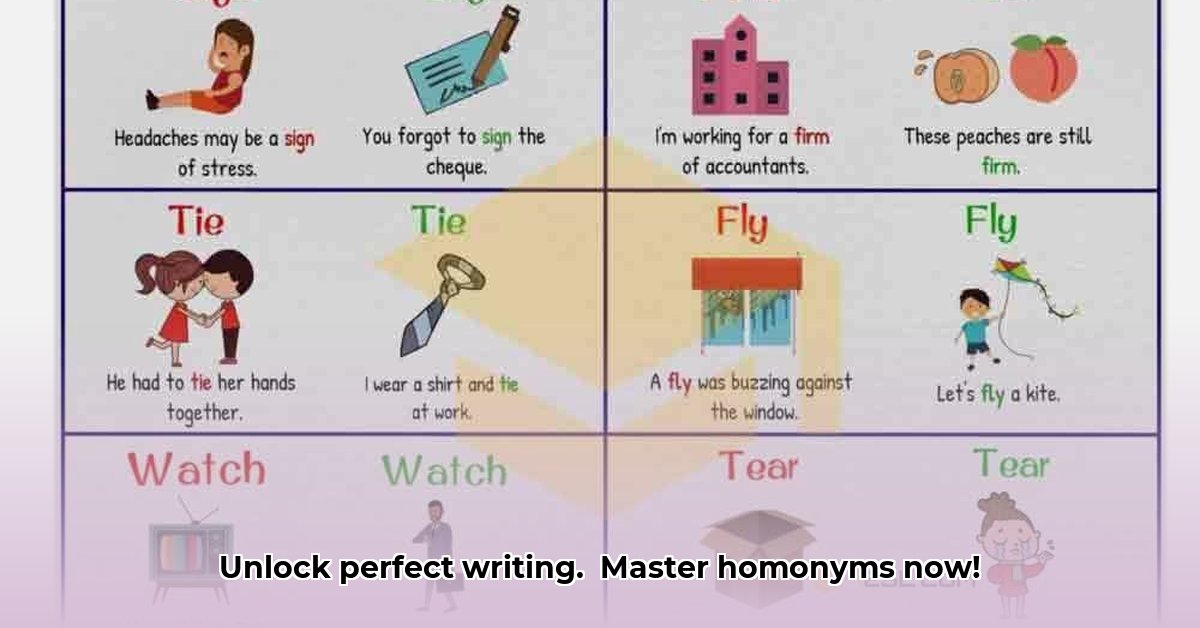
Understanding Homonyms, Homophones, and Homographs: A Linguistic Deep Dive
Have you ever accidentally used the wrong word, completely changing the meaning of your sentence? It happens to the best of us! Many words sound or look alike but have entirely different meanings. This is the fascinating—and sometimes frustrating—world of homonyms, homophones, and homographs. This guide will help you navigate these tricky terms and improve your writing significantly. We'll clarify the differences between them, providing clear explanations and easy-to-understand examples. You'll learn how to identify and correct these common errors, discover why this knowledge is crucial for various professions, and ultimately, write with greater accuracy and confidence.
Defining the Terms
Let's start by defining our key terms:
Homonyms: This is the broad term encompassing words that share either the same spelling, the same pronunciation, or both, but have different meanings. Think of them as linguistic twins with distinct personalities.
Homophones: These words sound exactly alike but are spelled differently and have distinct meanings. Examples include "hear" and "here," or "there," "their," and "they're." These are frequent sources of confusion.
Homographs: These words share the same spelling but have different meanings. They may or may not sound alike. For instance, "bat" (the flying mammal) and "bat" (the sporting equipment) are homographs. A clear understanding of context is needed when using them.
Perfect Homonyms: These are the trickiest of the lot. They share the same spelling and pronunciation but have entirely different meanings. An example is the word “fair” (meaning just or equitable) and “fair” (meaning an exhibition or carnival).
It's important to note that the categorization of some words can be debated, even among experts. Linguistics is a living field, and the classification of words can evolve over time.
Why Mastering Homonyms Matters
Why dedicate time to understanding homonyms? Because mastering them is essential for clear and effective communication. Imagine the confusion caused by a sentence like, "Their going to the bank to deposit they're money." Awkward, isn't it? Using the correct homonym ensures your writing is professional, credible, and avoids unintentional misinterpretations.
Mastering Homonyms: A Practical Guide
Here's a step-by-step plan to help you confidently use homonyms:
Expand your vocabulary: The more words you know, the easier it is to distinguish between similar-sounding or looking words. Read widely – novels, newspapers, articles – to enrich your lexicon.
Utilize dictionaries and thesauruses: These aren't just for spelling! They clarify meanings, show synonyms, and provide usage examples.
Context is crucial: Pay close attention to the words surrounding a potentially tricky word. The context helps you determine the intended meaning. Reading sentences aloud can aid in this process.
Practice makes perfect: The best way to learn is by actively using homonyms correctly in your writing, from emails to journal entries.
Homonym Spotlights: Common Examples
Let's examine some common homonym pairs with clear explanations:
| Homonym | Meaning 1 | Meaning 2 |
|---|---|---|
| see | to perceive with the eyes | the sea, a seaside resort |
| sea | a large body of salt water | to perceive with eyes |
| cent | one hundredth of a dollar | a perfume, a fragrance |
| scent | a smell, fragrance | one hundredth of a dollar |
| sale | the act of selling | a unit of area |
| sail | a piece of fabric (part of a boat) | the act of selling |
Actionable Advice for Professionals
Here's how different professionals can use this knowledge:
For Writers:
- Always proofread meticulously. Read your work aloud to catch errors that silent reading might miss.
For Editors:
- Pay close attention to homonyms; they're frequent writing errors. Develop a "homonym ear" to identify them quickly.
For Teachers:
- Use engaging examples and games to make learning homonyms fun and memorable for students.
For Software Developers:
- Develop tools that flag potential homonym errors, assisting writers in avoiding mistakes.
Conclusion: Write with Clarity and Confidence
Mastering homonyms isn't just about avoiding embarrassing errors; it's about improving communication, enhancing credibility, and achieving greater success in your writing. Consistent effort and practice will allow you to write with greater clarity, accuracy, and confidence. Embrace the challenge; the rewards are well worth it.